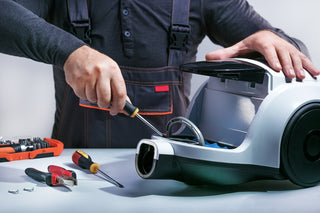A freshly vacuumed home looks nice, and feels nice, but did you know it’s also good for your health? Vacuuming eliminates many harmful allergens from your home, clearing it of dust, dirt, dust mites and mold. That, in turn, translates directly to improvements in air quality, sleep quality, mental well-being, and even the health of your skin, hair and eyes!
It’s important to vacuum weekly, if not more often, though putting regular mileage on your vacuum can lead to some breakdowns. The team at Vacuums 360 covers some of the health benefits of vacuuming your home, and then we touch on what to do when your faithful vacuum isn’t working as well as you need it to. Some common vacuum problems are easily solvable at home, but major ones need professional attention. If you’re looking for vacuum repair in Layton, South Jordan, Salt Lake City or Orem, Vacuums360 can handle any vacuum-related problem you run into!
Health Benefits of Vacuuming
- Air Quality
Your home is filled with allergens and particulates — dust, dirt, mites, dead skin and pet dander, among many others. Some of these are generated by you, your family members or your pets, and others are tracked in from outside, or even drift in through windows and doors.
Regardless of their source, this dust can have adverse effects on your respiratory health, especially if you have asthma or allergies. Vacuuming regularly can keep dust levels low and avoid lung irritation.
- Reduce Dust Mites
Dust mites are microscopic creatures that feed on tiny flakes of skin. There are huge numbers of them in your pillows, mattresses, and carpets, and they are one of the top sources of indoor allergens. (Experts estimate that a full 10% of a 2-year-old pillow’s weight is made up of dust mites!)
While dust mites are not, in and of themselves, harmful, the allergens they produce can be irritating to the human respiratory system. Regular vacuuming can keep levels of both dust mites and dust mite allergens down and alleviate allergic reactions in your home. (On top of vacuuming mattresses and pillow covers, steam cleaning carpets can also help combat dust mites.)
- Mold and Fungus Reduction
If you have carpeting, and especially if you live in a warm, humid climate, you have a significant chance of mold and fungus growth in your home. Like dust mites, mold and fungus can be serious allergens, especially to asthma and allergy sufferers. Regular vacuuming of all rugs and carpets, as well as assuring proper ventilation in your home, can prevent a mold problem in your home.
The Most Common Vacuum Problems and How to Fix Them
- Poor Suction
One of the most fundamental vacuum problems is poor suction. If you’re running your vacuum over dust or other matter and it’s simply not picking it up, you’re dealing with a loss of suction.
Your first move should be to check if the bag is full. A full bag will impede airflow enough to decrease suction immensely. Simply replacing the bag can restore your vacuum to full function.
However, if the bag has ripped or ruptured, the bag compartment may have a buildup of dirt, dust, and debris, which could impede airflow separate from the bag. Thoroughly check the bag compartment and, if necessary, clean it out.
Next, check the vacuum’s filters. The filters are there to filter out fine dust and larger debris that could cause a clog, and they can very easily become clogged themselves. Even if your suction isn’t totally lost, cleaning your filters can make a noticeable and immediate difference in your vacuum’s suction level.
Another likely spot for clogs is the hose. Larger items or tangles of material like thread or hair can easily become lodged in the hose and impede airflow. Carefully examine the length of your vacuum’s hose to make sure there are no clogs. While you’re at it, check for any cracks or fissures in the hose or around the seals where the hose meets the vacuum; even a small rupture can reduce your vacuum’s suction.
- A Burning Smell
A burning smell emanating from your vacuum can be alarming, but it’s rarely a sign of actual fire. Instead, it’s the result of excessive friction from a damaged or broken belt. While this is easily repaired, it will need professional vacuum repair.
- Your Vacuum Shuts Off by Itself
Most vacuums have an emergency failsafe mechanism that shuts the vacuum off when it overheats. So in one sense, it’s a good thing when your vacuum shuts itself off, as it’s a sign that your safety features are working properly.
So what’s causing the overheating? That can be a number of different problems; a serious clog will quickly generate excessive heat, and could trigger an auto shutoff. It could also be related to settings; if you have your vacuum set to the highest suction setting, and you’re using it on a very soft, thick surface such as carpeting, that could also lead to overheating, since you’re essentially creating a clog.
If you’ve checked your vacuum for clogs, and optimized its settings, and it still shuts off automatically during use, it may need vacuum repairs from a professional.
- Your Vacuum Won’t Power On
If your vacuum won’t turn on, start by eliminating the most obvious possibilities first. Is it plugged in? It may sound obvious, but many people overlook this basic requirement.
If it’s plugged in and turned on, inspect the power cord. If it’s frayed or ruptured, you may need professional vacuum repair from Vacuums360 with locations in Ogden, Provo, Spanish Fork and other northern Utah locations.


